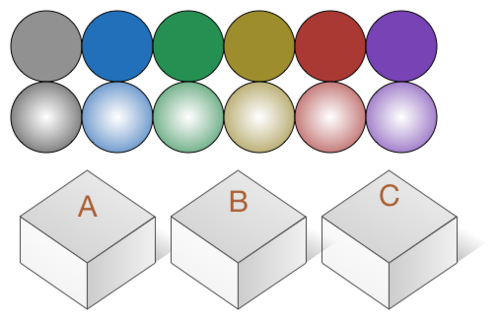JEE-Mains 2015 (30/30) - Modified
 If 12 distinct balls are to be placed in 3 distinct boxes
A
,
B
,
C
, then the probability that box
A
contains exactly 3 balls is?
If 12 distinct balls are to be placed in 3 distinct boxes
A
,
B
,
C
, then the probability that box
A
contains exactly 3 balls is?
There was error in the exact question which appeared in JEE-Mains 2015. The question posted is modified.
This section requires Javascript.
You are seeing this because something didn't load right. We suggest you, (a) try
refreshing the page, (b) enabling javascript if it is disabled on your browser and,
finally, (c)
loading the
non-javascript version of this page
. We're sorry about the hassle.
1 solution
I would disagree. The probability should be slightly slower. You have double counted the scenarios where the ball distribution is 3-3-6.
Log in to reply
I did realize that there was some ambiguity in the use of the word "particular". I interpreted it to mean that there was a specific box that had to have exactly 3 balls in it, without further conditions on how the remaining balls were placed in the other two boxes. If it meant that exactly one of the boxes had to have precisely 3 balls in it then my solution would be an over-count as you say, but for my interpretation I still think that I have the right value. Perhaps if the word "particular" were replaced with "specific" then the ambiguity would be dealt with and the posted solution could then remain as it is.
Log in to reply
Ah, so you answered it as "Box A has exactly 3 balls". K, that would make more sense, and I now follow your solution.
Log in to reply
@Calvin Lin – Great. The edited phrasing of the question is crystal clear now. :)
We can place exactly 3 distinct balls in the "particular" box in ( 3 1 2 ) = 2 2 0 ways. The remaining 9 distinct balls can be placed in the remaining 2 distinct boxes in any of 2 9 ways.
Then since there are 3 1 2 ways of placing the 1 2 balls into the boxes without restrictions, the desired probability is
3 1 2 2 2 0 ∗ 2 9 = 2 2 ∗ 3 ∗ 3 1 1 2 2 0 ∗ 2 1 1 = 3 5 5 ( 3 2 ) 1 1 .